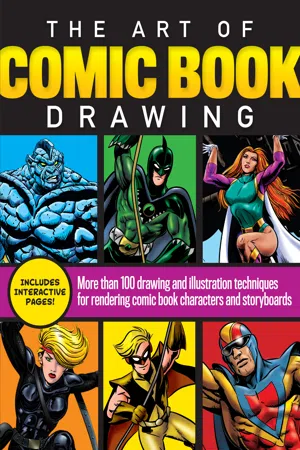
The Art of Comic Book Drawing
More than 100 drawing and illustration techniques for rendering comic book characters and storyboards
- 128 pages
- English
- ePUB (mobile friendly)
- Available on iOS & Android
The Art of Comic Book Drawing
More than 100 drawing and illustration techniques for rendering comic book characters and storyboards
About This Book
Wham! Pow! Bam! Kaboom! Learn everything you need to make your own comic books, superheroes, and story lines with The Art of Comic Book Drawing. Featuring step-by-step tutorials, helpful tips, and dozens of drawing and illustration techniques, aspiring cartoonists, graphic illustrators, and comic book artists will discover all of the basics, from creating characters to mastering features and expressions to bringing it all together with unique and interesting story lines. Veteran comic book artists teach you to draw basic cartoon characters, superheroes, villains, and more using simple, step-by-step drawing lessons. Once you get the hang of illustrating your favorite characters, you'll learn to draw action scenes, set up panels, add speech bubbles, and even learn the basics of cartoon and comic book word treatments. With approachable exercises and projects to guide you, The Art of Comic Book Drawing allows beginning artists to create their own comic books, step by step. This helpful guide also includes easy-to-use comic book templates so you can put your newfound skills to immediate use.
Frequently asked questions
Information
Building Comic Characters

PROPORTIONS

PLAYING WITH PROPORTIONS

DRAWING THE FIGURE IN SPACE
Table of contents
- Cover
- Title Page
- Contents
- Introduction
- Tools & Materials
- Digital Illustration
- Drawing Basics
- Inking Techniques
- Creating Characters
- Bodies in Motion
- Villains
- Battles
- Building Comic Characters
- Adding Speech
- About the Artists
- Copyright